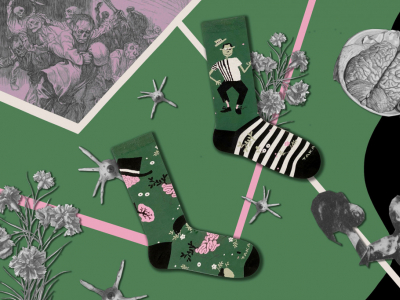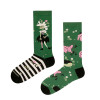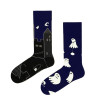Haunted socks and ancient Slavic customs
The turn of October and November is an important time for different cultures. Nowadays Halloween customs are very popular around the world, in Mexico and Spanish-speaking countries Dia de Muertos is celebrated. In Poland the beginning of November is mostly associated with All Saints' Day and All Souls' Day. All of these traditions are related to the theme of the intermingling of the worlds of the living and the dead. The tradition of Dziady, which originated from the beliefs of the Slavs and Balts, was once popular in Poland. It is a time for you to make yourself comfortable in an armchair, put on socks with black cats or socks with zombies and plunge into the world of our ancestors. The very name of the ritual had a multi-layered meaning. On the one hand, the word grandfather was used to describe the oldest members of the family, but also wanderers, who were believed to have magical powers and the ability to contact the dead. Grandfathers were also the spirits of ancestors, who returned at this time of year to their old homes to visit their loved ones. In pre-Christian culture, communing with the world of ghosts, spirits and magical creatures was part of everyday life. People believed that there are many unexplained phenomena in the world, which depend, among other things, on the cycle of nature or the phases of the moon. The feast was celebrated twice a year: in the spring and in the autumn, which was connected to the phases of the moon. The purpose of all the rituals was to show respect to the dead, as well as to help direct them to the land of the dead. Many people believed that during Dziady it was possible to meet their loved ones who had already been taken away by death.
Visitors from beyond the grave
The awaited guests had to be welcomed in an appropriate way, and moreover, care had to be taken not to accidentally scare them away. One of the most important elements of the evening was a specially prepared feast, which took place in houses and on the graves of the dead. Kutia and meat were served. A deliberate trick was to drop some of the food on the floor and on the graves, so that the dead could also eat. A very important role was played by fire, which had several functions. First of all, it warmed the spirits and showed them the way so that they could easily find their old homes. Fire was burned in stoves, but bonfires were also lit, for example at crossroads. Contemporary candles are a consequence of this tradition. Fire was also used to scare away demons, which were more active that evening. Some activities were forbidden, because they could frighten away the spirits. For example, it was forbidden to clean up after the supper, so that visitors from another world could eat the crumbs. During the ritual of Forefathers' Eve an important role was played by wandering beggars, who were called "grandfathers". They were welcomed into homes and offered food. They were believed to have a special ability to mediate between the world of the living and the dead.



